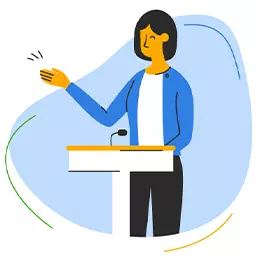
Worksheets & References
I know of no more encouraging fact than the unquestioned ability of a man to elevate his life by conscious endeavor.
– Henry David Thoreau
Introduction
While this course has come to an end, we hope that your road toward improved public speaking abilities has just just begun. Kindly evaluate and revise your action plan. This will be a critical tool in guiding your growth over the next days, weeks, months, and years. We wish you the best of success with your remaining studies!
| Module | Goal | Specific? | Measurable? | Achievable? | Relevant? | Timed? | Next Steps |
| One | |||||||
| Two | |||||||
| Three | |||||||
| Four | |||||||
| Five | |||||||
| Six | |||||||
| Seven | |||||||
| Eight | |||||||
| Nine | |||||||
| Ten |

Worksheet One: Enliven a Conversation (Review Points)
For a talk to be effective, the presenter should build interest, understanding and retention, involve participants, and reinforce what has been presented. Below are ten tips.
Building interest
- Lead-off story or interesting visual. Provide a relevant anecdote, fictional story, cartoon, or graphically captures the audience’s attention.
- Initial case problem. Present a problem around which the lecture will be structured.
- Test question. Ask participants a question (even if they have little prior knowledge) so that they will be motivated to listen for the answer.
Maximizing understanding and retention
- Reduce the major points in the talk to keywords that act as verbal subheadings or memory aids.
- Examples and analogies. Provide real-life illustrations of the ideas in the talk and, if possible, create a comparison between your material in the knowledge and experience the participants already have.
- Visual backup. Use flip charts, brief handouts, and demonstrations that enable participants to see as well as hear what you are saying.
Involving participants during the talk
- Spot Challenges. Interrupt the talk periodically and challenge participants to give examples of the concepts presented thus far, or to answer spot quiz questions.
- Illuminating Activities. Intersperse brief activities that illuminate the points you are making.
Reinforcing the talk
- Application Problem. Post a problem or question for participants to solve based on the information given in the talk.
- Participant Review. Ask participants to review the contents of the talk with one another or give them a self-scoring review test.
Worksheet Two: The Hand Gestures
Gestures of direction, size, shape, description, feeling and intensity are all effective when speaking. Practice each type with your partner as you read a few of the short statements below. Word clues are italicized for you.
Direction
- She jumped off the dock and sank straight down to the bottom of the lake.
- We circled the airport for what seemed like hours until the fog lifted.
- The car was headed south, toward the border.

Size, shape, and description
- Lying in the pail was the biggest frog I’d ever seen. But before I could grab him…
- On approach, the plane dipped before veering slightly to the right.
- It is a large wheel, maybe the size of a salad plate. On one side, it has teeth designed to mesh on the shaft.
Feeling and intensity
- I have tried to get the board to realize that this project is critical to the success of water system, but I have failed.
- I was so excited when on my first visit, we finally landed in Hong Kong!
- The team was so close to winning the pennant, but they just blew it.How much more can the fans take?

Worksheet Three: Transmitting Messages
People who are excellent communicators are sensitive to the power of the emotions and thoughts communicated non-verbally through signals. Again using the statements from the Gestures exercise, select a few and practice reinforcing your message through the use of eye contact, posture, body movements, and tone of voice. Share observations with others if you can.
Direction
- She jumped off the dock and sank straight down to the bottom of the lake.
- We circled the airport for what seemed like hours until the fog lifted.
- The car was headed south, toward the border.
Size, shape, and description
- Lying in the pail was the biggest frog I’d ever seen. But before I could grab him…
- On approach, the plane dipped before veering slightly to the right.
- It is a large wheel, maybe the size of a salad plate. On one side, it has teeth designed to mesh on the shaft.
Feeling and intensity
- I have tried to get the board to realize that this project is critical to the success of water system, but I have failed.
- I was so excited when on my first visit; we finally landed in Hong Kong!
- The team was so close to winning the pennant, but they just blew it. How much more can the fans take?
Worksheet Four: Vibrant Tone of Voice
Exercise a):Moving your voice around
- Press your hand on your nose and say “nose”.
- Concentrate on your nose as you repeat the word until you can feel your nose vibrating.
- Now do the same exercise with your hand on your throat saying “throat”.
- And finally on your chest saying “chest”.
- Keep practicing until you can really feel the vibration in each place.
- Notice how different each one sounds.

Exercise B): Using your range
- Starting from a high note, say ‘ar’ (as in the letter r) keeping your mouth open allow the note to drop down until your breath runs out.
- Repeat this ten times.
- Starting from a low note, say ‘ou’ (As in you without the y), allowing the note to rise until you cannot support the sound.
- Repeat this ten times.
Exercise C): Resonate
To use your voice correctly it must resonate in the facial area surrounding the nose and mouth.
There are two ways to do this:
- Hum at whatever pitch is most comfortable for you. When you have found your pitch, hum ‘umm’ followed immediately by the word ‘ready’. Repeat a few times, then try the words ‘now’, ‘one’, ‘two’, ‘three’.
- Hum, and then allow your lips to vibrate. You are attempting to sound like a dove. Allow the pitch to rise and fall. This is very difficult if there is any tension in the jaw or face. Done correctly for a few minutes, your face will start to feel numb. After a few minutes, you should notice that your voice sounds crisper, and the sound has better attack.
Spending 5 minutes a day practicing these exercises will enhance your voice tone.

Worksheet Five: Amusing Opening Statements
As you deliver one of the openers below, think about how your body language can reinforce the message.
“If you are wondering if this will be a boring presentation, you are not alone. I’m dying to know too.”
“I’d like to make three important points. That’s the first one. Can’t remember the other two.”
“They said keep it short and simple, so thanks for listening and goodbye.”
“You’re thinking, how will I start? Don’t. Your real problem is when will I stop.”
“Some of you have heard me speak before. The rest of you have something to look forward to.”
“I’ve been working on this material for months. Fortunately, last night my dog ate it.”
Bibliography
Bailey, F. (2009) Public Speaking in an Instant. Career Press.
Koegel, T.J. (2007) The Exceptional Presenter: A Proven Formula to Open up and Own the Room.
Greenleaf Book Group.
Kushner, M. (2004) Public Speaking for Dummies. For Dummies.
Lucas, S.E. (2003) The Art of Public Speaking. McGraw Hill.





